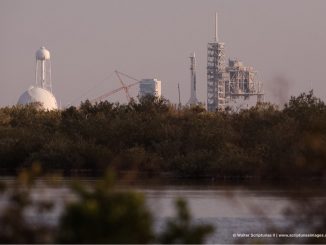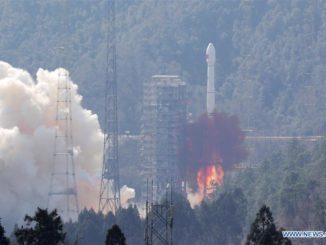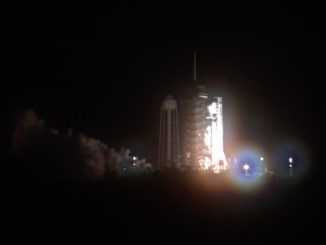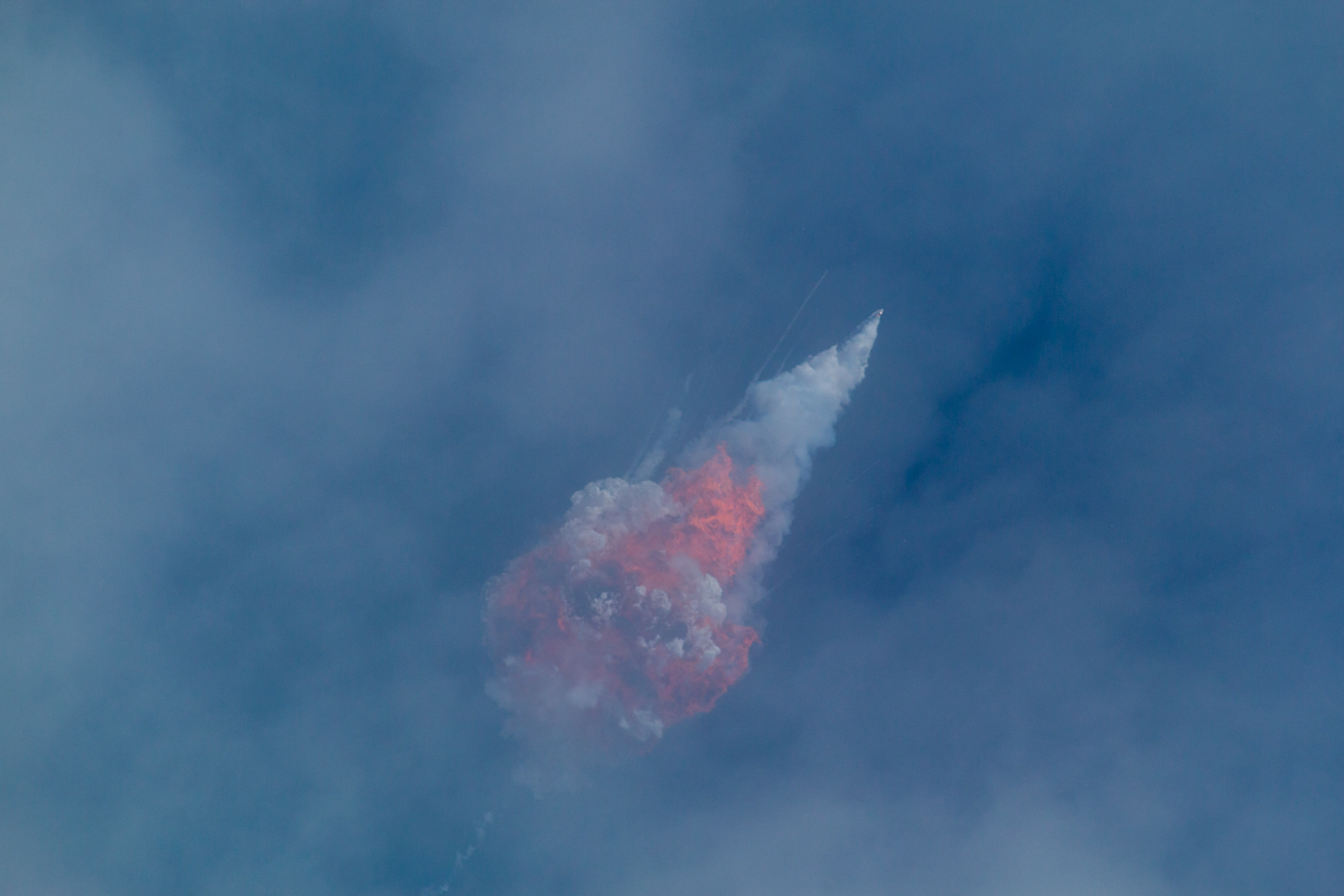
SpaceX performed a dramatic high-altitude test flight Sunday of the company’s Crew Dragon capsule over Florida’s Space Coast, testing the human-rated ship’s ability to escape a rocket failure and save its crew before two NASA astronauts strap in for a flight to the International Space Station as soon as this spring.
The unusual test flight included an intentional failure of the Crew Dragon’s Falcon 9 rocket about a minute-and-a-half after liftoff from the Kennedy Space Center. The rocket, with a recycled first stage booster flown three previous times, disintegrated in a fireball high over the Atlantic Ocean as the crew capsule sped away from the top of the launcher with a powerful boost from eight SuperDraco engines.
The SuperDraco engines — mounted around the circumference of the gumdrop-shaped crew capsule — fired around eight seconds to carry the spaceship a safe distance from the Falcon 9 rocket after the booster’s first stage engines shut down, a standard part of the launch escape sequence.
The Crew Dragon arced on a ballistic trajectory to a top speed of about Mach 2.2 and a peak altitude of about 131,000 feet, according to Elon Musk, SpaceX’s founder and chief executive. The capsule then deployed four main parachutes for a splashdown in the Atlantic Ocean roughly 20 miles (32 kilometers) east of the Kennedy Space Center.
Crew Dragon separating from Falcon 9 during today’s test, which verified the spacecraft’s ability to carry astronauts to safety in the unlikely event of an emergency on ascent pic.twitter.com/rxUDPFD0v5
— SpaceX (@SpaceX) January 19, 2020
Musk, NASA officials and astronauts were pleased with the performance of the Crew Dragon’s launch escape system.
“I’m super fired up,” Musk said. “This is great … We’re looking forward to the next step.”
NASA has signed agreements with SpaceX valued at more than $3.1 billion since 2011 to fund the design, development, construction and testing of the Crew Dragon spacecraft.
The next major step for the Crew Dragon program is the capsule’s first trip to space with astronauts. The Crew Dragon’s in-flight abort test Sunday was the last major flight demonstration of a full-scale Crew Dragon spacecraft before its first launch with humans on-board.
Veteran NASA shuttle fliers Doug Hurley and Bob Behnken are training for the mission — designated Demo-2 — to fly the Crew Dragon to the International Space Station.
Musk said after Sunday’s in-flight abort test that the Demo-2 mission would likely launch in the second quarter of this year — between the beginning of April and the end of June — although rocket and spacecraft hardware for the Demo-2 flight could be in place at the Kennedy Space Center by the end of February or early March.
“The hardware necessary for first crewed launch, we believe, will be ready by the end of February,” Musk said. “However, there’s still a lot of work once the hardware is ready to cross-check everything, triple-check, quadruple-check, go over everything again so that every stone has been turned over three or four times.
“And there is also the schedule for getting to (the) space station because space station has a lot of things going to it, so what’s the right timing for this?” Musk said. “The sort of collective wisdom at this point is we’re highly confident the hardware will be ready in Quarter 1, most likely the end of February, but no later than March, and that it and it would appear probable that the first crew launch would occur in the 2nd Quarter.”

In the meantime, SpaceX will collect all the data from the Crew Dragon abort test and analyze the results for any potential problem areas. NASA is also reviewing numerous Crew Dragon data packages provided by SpaceX before agreeing to fly Hurley and Behnken on SpaceX’s next crew capsule launch.
SpaceX plans at least two more atmospheric drop tests of the Crew Dragon parachute system to gain more confidence in the capsule’s decelerators, which have been a problem area on the project after chute failures on a cargo-carrying Dragon spacecraft and in Crew Dragon testing.
Engineers found that NASA was using wrong assumptions in models that predict how much force parachutes experience on spacecraft returning to Earth. Data from testing showed the parachute risers, or suspension lines, encountered more significant loads than expected, raising concerns about chutes across the agency’s human spaceflight programs, including on the Starliner commercial crew capsule being developed by Boeing.
SpaceX and NASA agreed to switch to a new generation of Crew Dragon parachutes dubbed the Mark 3, and testing of the new Mark 3 chutes — made by a company named Airborne Systems — has proceeded without failure since late last year.
Sunday’s in-flight abort test provided the parachute engineers with another successful test of the Mark 3 chutes, adding additional confidence about the system’s reliability.
NASA Administrator Jim Bridenstine called Sunday’s abort test “another amazing milestone” in the agency’s nearly decade-long effort to resume crew launches to the space station from U.S. soil.
“Make no mistake, there’s a lot left to do,” Bridenstine said. “We have a number of parachute tests upcoming, and of course, we’re going to get a lot of data from this particular test. So we’re not quite there yet, but by all accounts, this was a very successful test.”
After a one-day delay due to rough seas in the splashdown zone — and a two-and-a-half-hour hold Sunday to wait for improved winds — the Crew Dragon spacecraft lifted off on top of a SpaceX Falcon 9 rocket at 10:30 a.m. EST (1530 GMT) Sunday from pad 39A at Kennedy, the same launch pad once used by NASA’s Saturn 5 moon rockets and space shuttles.
The 215-foot-tall (65-meter) rocket flew off the launch pad powered by nine kerosene-fueled Merlin 1D engines and pitched on an easterly trajectory from the Florida spaceport.
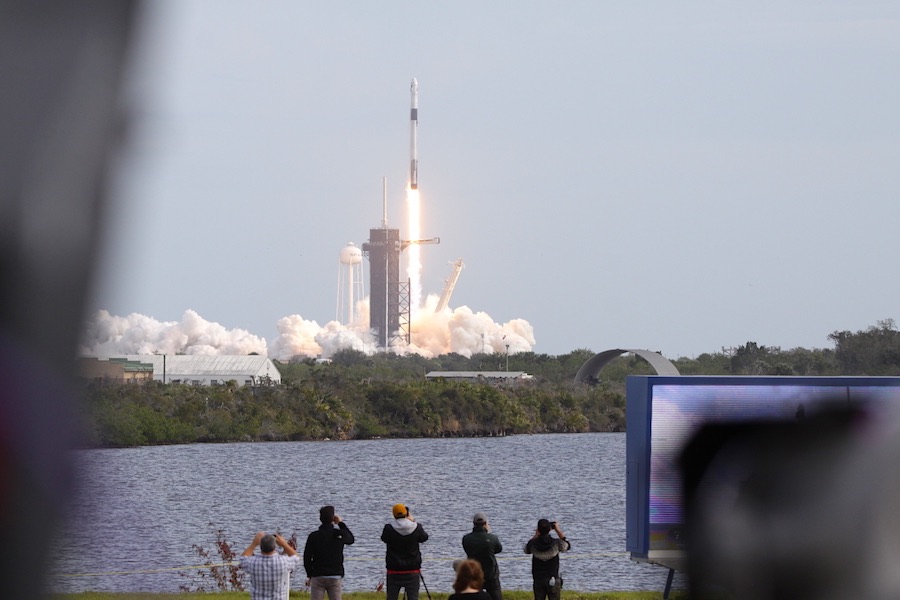
The Falcon 9 surpassed the speed of sound in less than a minute, and the Crew Dragon’s pre-programmed escape sequence initiated around 84 seconds after liftoff, when the rocket was at an altitude of roughly 62,000 feet (19 kilometers).
The abort was triggered soon after the point in the launch sequence where the booster and capsule experience the most extreme aerodynamic pressures.
While the nine Merlin engines on the Falcon 9 rocket cut off in response to the escape command, nearly 130,000 pounds of thrust from the SuperDraco engines pushed the Crew Dragon rapidly away from the top of the launcher.
SpaceX said the capsule, and two mannequins seated inside, accelerated at about 3.5Gs during the abort, a relatively gentle ride for astronauts in good physical condition.
The Crew Dragon can initiate an abort and free itself of a failing launch vehicle in just 700 milliseconds, according to Musk.
“It’s way more than a human could do,” he said. “It’s occurring in a fraction of a second. There’s a command for the engines to shut down, and then the abort system then presses up very rapidly, the SuperDracoss are ignited to initiate separation from the upper stage. All of this is occurring in literally a split second, and it’s really quite remarkable how quickly those engines reach full thrust.”
The SuperDracos keep the Crew Dragon pointed in the right direction using differential thrust, Musk said.
“So it’s making those thrust adjustments at the almost millisecond level,” he said. “It’s very, very fast.”
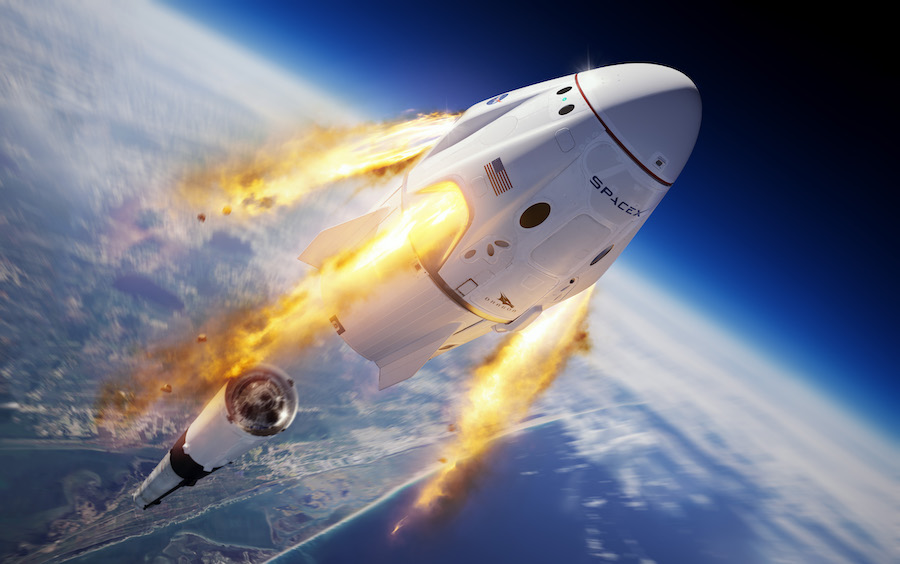
Sunday’s in-flight abort test builds on a Crew Dragon demonstration in 2015 that proved the craft’s SuperDraco engines could safely boost itself away from the top of a rocket on the launch pad in the event of a preflight emergency.
The Crew Dragon successfully flew to the International Space Station in March 2019 on its first unpiloted space mission, named Demo-1. The round-trip six-day mission included a launch on a Falcon 9 rocket from Kennedy, an automated docking with the orbiting research laboratory, and a splashdown in the Atlantic Ocean.
But SpaceX suffered a setback the next month when the same Crew Dragon spacecraft was destroyed during an attempted test-firing of its SuperDraco engines on a test stand at Cape Canaveral.
Investigators determined the Crew Dragon explosion on the ground last April was caused by a leaky valve that allowed nitrogen tetroxide — the oxidizer that feeds the SuperDraco engines — into the abort propulsion system’s high-pressure helium lines. When the system pressurized before ignition, the nitrogen tetroxide was driven back against the valve, leading to an ignition event that destroyed the vehicle.
SpaceX replaced the faulty valve with a “burst disk” to block the pathway and prevent similar leaks. The disk designed for rupture when the abort system pressurizes.
Musk said the Crew Dragon’s abort system, which is integrated on the crew module itself instead of using a top-mounted launch abort tower like the Apollo spacecraft or Russia’s Soyuz capsule, comes with the benefit of enabling an abort maneuver from before the time of liftoff all the way through the Falcon 9’s ascent to orbit.
“The fact that the launch abort system is integrated with the spacecraft, with the SuperDraco thrusters in the sidewall, means that you have launch abort capability all the way to orbit, whereas previously with launch escape tower — because that’s top heavy — that is discarded 20 or 30 percent of the time into flight.”
SpaceX designed the SuperDracos with another purpose in mind.
The company originally intended to use the high-power engines to slow the Crew Dragon for propulsive vertical landings on solid ground, aiming to achieve a helicopter-like precision similar to the braking burns and landings performed by SpaceX’s Falcon rocket boosters.

SpaceX gave up on that goal after determining it would be too difficult to certify the propulsive landings for crew missions, company officials said.
The SuperDracos proved to be a difficult part of the Crew Dragon’s development, Bridenstine said.
The escape engines appeared to perform well Sunday, along with other Crew Dragon systems, according to Musk.
While wreckage from the Falcon 9 booster fell to Earth at high speed, the Crew Dragon’s parachutes slowed the capsule for an ocean landing. Winds in the splashdown area were near the limit for a Crew Dragon return.
The winds at the splashdown zone were around 18 mph, or 16 knots, providing data on the performance of the parachutes under more stressing conditions than they might see on a typical return, Musk said.
U.S. military search and rescue teams deployed in the Atlantic Ocean practiced procedures to approach the capsule after splashdown. The teams from Patrick Air Force Base just south of Cape Canaveral would rescue astronauts from the spacecraft after a launch abort.
SpaceX’s “Go Searcher” recovery ship hoisted the capsule from the sea and returned the Crew Dragon to Port Canaveral, where teams will offload the ship to begin inspections and analysis.
The schedule for the Demo-2 launch with Hurley and Behnken will partly be determined by a NASA decision in the coming weeks on whether to extend the length of their mission at the space station from a short-duration stay of about a week to an expedition that might last as long as several months.
Bridenstine said the Demo-2 crew will have to undergo additional training to perform duties on the space station if NASA extends Hurley and Behnken’s mission.
Kathy Lueders, NASA’s commercial crew program manager, suggested Friday that the Demo-2 mission might be ready for launch as soon as the first half of March.
But it’s more likely to happen in April — at the soonest — when the space station’s crew is downsized to three people through October, assuming no U.S. crew launches in that period.
“We might look at making that first crew be a long-duration crew for the purpose of getting the max amount of capability out of the International Space Station,” Bridenstine said. “Bascially we’ll be able to maintain a larger presence of astronauts on the space station for a longer period of time.
“I’m not saying this is the direction we’re going to go,” he added. “We just haven’t decided, yet and we’re working through it … Given what looks like to be a very successful test (Sunday), we now have options, so that’s a positive thing.”
Boeing, NASA’s other commercial crew partner, is readying its Starliner crew capsule for its first space mission with people later this year. The first Starliner unpiloted orbital test flight in December failed to reach the space station due to a software timing error that caused the ship to burn too much fuel just after an otherwise-successful deployment in space from a United Launch Alliance Atlas 5 rocket.
NASA is reviewing the results of the Starliner test flight to determine if the next Boeing crew capsule launch can carry astronauts, as officials originally intended. Boeing astronaut Chris Ferguson and NASA astronauts Mike Fincke and Nicole Mann are assigned to the first Starliner crew flight.
When Boeing’s first piloted Starliner mission might fit on the space station’s schedule of visiting vehicles remains uncertain. NASA has already approved an extended-duration Starliner test flight that could allow Ferguson, Fincke and Mann to remain on the space station up to six months.
Chris Cassidy is set to launch to the station in April on a Russian Soyuz spacecraft with two Russian crewmates. Cassidy will fly on the last Soyuz seat under NASA control before the commercial crew vehicles begin flying regular crew rotation missions, a milestone to come after the initial test flights with astronauts.
Cassidy is scheduled to return to Earth in October, at which point the space station will not have a U.S. crew member unless NASA buys more Soyuz seats from Russia or a commercial crew vehicle successfully docks at the orbiting outpost.
While it looks increasingly likely at least one of NASA’s commercial crew transportation providers will launch astronauts to the space station before October, Bridenstine said Sunday the agency will proceed with plans to procure at least one more Soyuz seat from Roscosmos, the Russian space agency.
“As much confidence as we have in the team, I think it’s probably not prudent to go in that direction,” he said. “I think it’s important that we have options … and make sure that the International Space Station has continuous American presence, so we’re not ready to make any adjustments on that front. We’re going to buy another Soyuz seat.”
NASA has paid the Russian government some $3.9 billion since the space shuttle’s retirement in 2011 for seats on Soyuz crew ferry vehicles flying to and from the space station.
Once the Boeing and SpaceX crew capsules are declared operational, the U.S. capsules will begin flying Russian cosmonauts. NASA astronauts will continue launching and landing on Soyuz spaceships through an “in-kind” arrangement involving no exchange of funds.
The arrangement ensures at least one Russian cosmonaut and one U.S. astronaut are always on the space station, even if the Soyuz, Crew Dragon or Starliner is grounded by a technical concern.
With a U.S. crew vehicle on the cusp of launching astronauts into orbit for the first time since 2011, Musk said the space industry is at a “profound” moment.
“I think the United States is very much a nation of explorers,” he said. “Anyone who has an adventurous bone in their body is going to be very excited about this, and I think it will help reinvigorate interest in space.”
“I think it’s something that matters to all Americans and to people worldwide.”
Email the author.
Follow Stephen Clark on Twitter: @StephenClark1.

